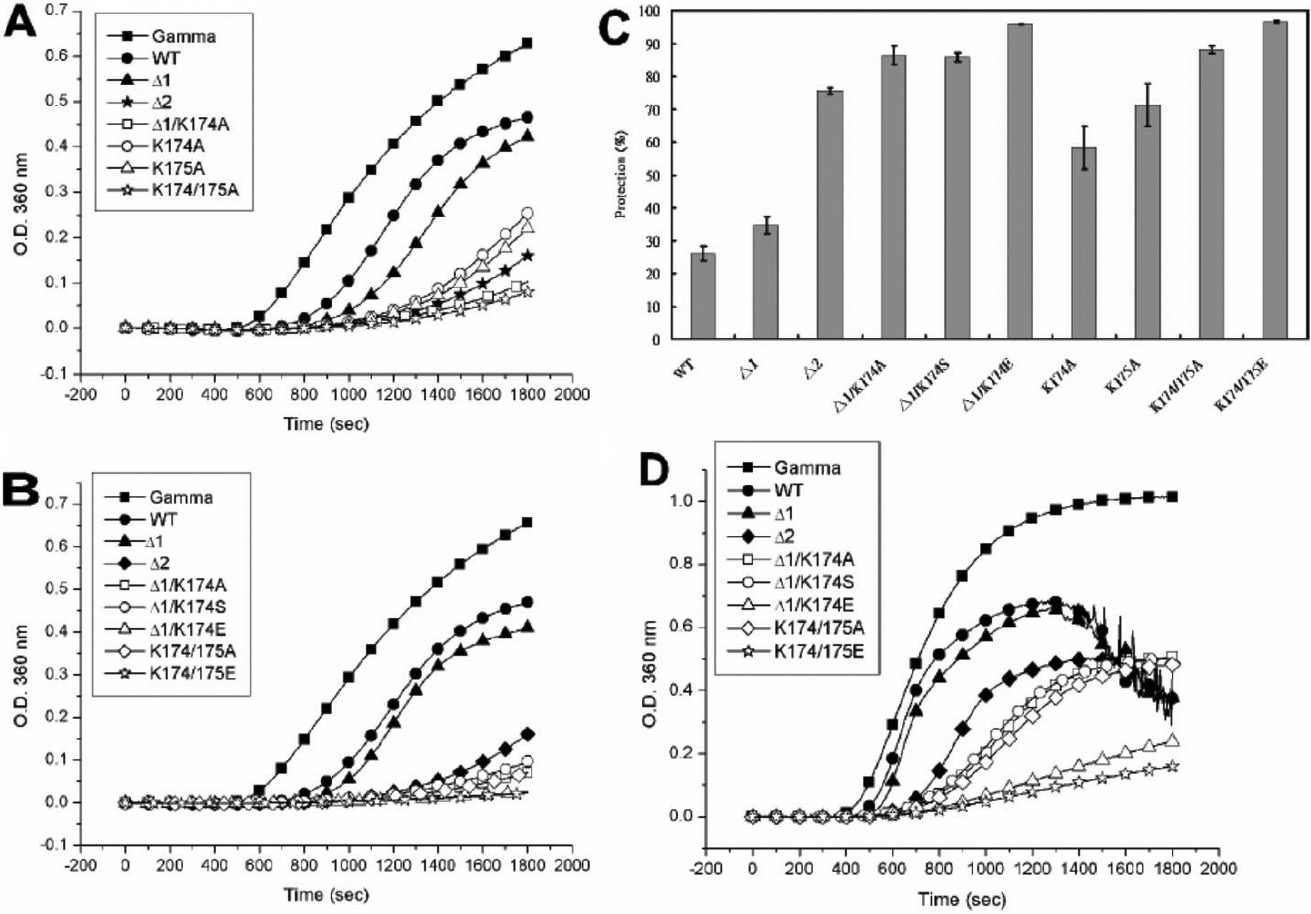Figure 7. Comparison of chaperone
activities of wild-type αB-crystallin and its mutants under thermal
denaturation. A: Porcine α-crystallin was used as a substrate
for chaperone-activity assays of wild-type αB-crystallin and mutants at
65 °C. Mutant proteins and wild-type αB-crystallin showed different
chaperone activities at a molar ratio of 2:3 (chaperone/γ-crystallin).
The scattering curves at 360 nm in the presence of chaperoning
crystallins are shown as follows: control solution without chaperone
(closed square), wild-type αB-crystallin (closed circle), Δ1 (closed
triangle), Δ2 (closed asterisk), Δ1/K174A (open square), K174A (open
circle), K175A (open triangle), and K174/175A (open asterisk). It is
noted that K174/175A and Δ1/K174A show the highest activity among all
mutants. B: Comparison of chaperone activities of wild-type
αB-crystallin and mutants with different electrostatic amino acids
under identical conditions as in A. The scattering curves at
360 nm in the presence of chaperoning crystallins are shown as follows:
control solution without chaperone (closed square), wild-type
αB-crystallin (closed circle), Δ1 (closed triangle), Δ2 (closed
rhombus), Δ1/K174A (open square), Δ1/K174S (open circle), Δ1/K174E
(open triangle), K174/175A (open rhombus), and K174/175E (open
asterisk). C: Comparison of chaperone activity (percentage
protection) of wild-type αB-crystallin and mutants. Wild-type
αB-crystallin was shown to possess poor protective activity and
K174/175E shown to possess the best protective activity among all
proteins. The final concentration of porcine α-crystallin is 5.5 μM. D:
Chaperone activities of wild-type αB-crystallin and its mutants under
thermal denaturation at 70 °C. Porcine α-crystallin was used as a
substrate for chaperone-activity assays of wild-type αB-crystallin and
its mutants with different electrostatic amino acids at 70 °C in a
molar ratio of 2:3 (chaperone/γ-crystallin). The scattering curves at
360 nm in the presence of chaperoning crystallins are shown as follows:
control solution without chaperone (closed square), wild-type
αB-crystallin (closed circle), Δ1 (closed triangle), Δ2 (closed
rhombus), Δ1/K174A (open square), Δ1/K174S (open circle), Δ1/K174E
(open triangle), K174/175A (open rhombus), and K174/175E (open
asterisk). Both Δ1/K174E and K174/175E show the best protective
activity among all mutants under these conditions. The final
concentration of porcine α-crystallin is 5.5 μM.

 Figure 7 of Liao, Mol Vis 2009; 15:1429-1444.
Figure 7 of Liao, Mol Vis 2009; 15:1429-1444.  Figure 7 of Liao, Mol Vis 2009; 15:1429-1444.
Figure 7 of Liao, Mol Vis 2009; 15:1429-1444. 